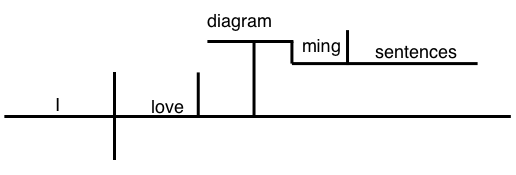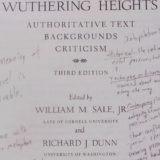I Love Diagramming Sentences – Resources for the Rebel
 It’s true, I love diagramming sentences, and I teach students how to diagram sentences–which is probably enough to get me kicked out of most professional English teacher organizations–if I belonged to any (which I don’t).
It’s true, I love diagramming sentences, and I teach students how to diagram sentences–which is probably enough to get me kicked out of most professional English teacher organizations–if I belonged to any (which I don’t).
But for you rebels out there who subversively sneak diagramming into your curriculum between studying for state and national tests, here are some resources from the Diagramming Sentences page at the Guide to Grammar and Writing sponsored by the Capital Community College Foundation:
- First, this quote by Gertrude Stein: “I really do not know that anything has ever been more exciting than diagramming sentences.”
- Second, this PowerPoint presentation on the basics of diagramming.
- Third, two pages of examples of basic and advanced diagrams:
- Fourth, the totally cool diagrams of both the Pledge of Allegiance and the Preamble to the U.S. Constitution. (Thanks to Boing Boing)
And finally, this tribute to diagramming from Investor’s Business Daily, October 17, 2000:
When Joseph R. Mallon Jr. bumps up against a complex problem, he thinks back to a lesson he learned in high school from the Sisters of the Immaculate Conception.
The Philadelphia-area school’s Catholic nuns taught him the art of diagramming a sentence. Once all the parts of speech lined up, Mallon pulled clarity from the chaos. It’s a process he uses today to tackle tough issues as chief executive and chairman of Measurement Specialties Inc.
“Sit down quietly. Take (the issue) apart into its component parts. Make sure all the components fit together well. They’ve got to be well chosen, fit together and make sense. There are few (business) problems that can’t be solved that way, as dire as it might seem,” Mallon said. “Sentence diagramming is one of the best analytical techniques I ever learned.”













I went to two different middle schools and three different high schools, and as a result of this disjointed learning, I never learned how to diagram sentences. I have tried to make out diagramming in various grammar books, and I just don’t get it. At this point, I guess it’s a mental block or something. Thanks for sharing these resources, though. Maybe I’ll give it another whirl and be successful this time.
It does have its uses that is for sure. You can’t have too many tools!
Lately I have been on a diagramming kick when I realized this might help my students with grammar. They love it, although it is quite challenging for them. I even taught diagramming during my yearly observation.
I think it is one of those things lost as the “good educational practices” pendulum took its swing sometime in the 70s.
I guess that makes me a subversive rebel also.
I love diagramming sentences so much that I’m starting a website devoted to teaching English grammar through sentence diagramming!
It’s so beneficial in teaching grammar as well as thinking skills, and when I taught diagramming to my students, they completely loved it.
I am new to sentence diagramming, and would appreciated some help with the following:
“The planets nearest the sun were the first to have their revolutions slowed down by tidal friction. Such gravitational influences also contribute to the stabilization of planetary orbits while acting as a brake on the rate of planetary-axial revolution, causing a planet to revolve ever slower until axial revolution ceases, leaving one hemisphere of the planet always turned toward the sun or larger body, as is illustrated by the planet Mercury and by the moon, which always turns the same face toward Earth.”
I have tried, but keep getting stuck.
Hi, I facilitate a Sunday school class and we are studying Romans. The first four verses are a complex sentence that I would like to diagram. I have tried and am having difficulty. Can you try for me. I teach 1st and 2nd grade in CA, and only need to diagram with them the subject noun and verb. Thanks!
I’m thrilled to have found this Web site and all the wonderful resources. I learned how to diagram sentences in fifth grade. I’m now a freelance writer, and I still collect books on diagramming sentences.
It’s a shame that the majority of schools no longer teach this lost art.
I´m stuck. Could I get help in diagramming the following sentence?
Such a snipping and pasting, planning and stitching as went on in the big back room, which was given up to them, and such a noble array of banners and pennons as soon decorated its walls, would have caused the dullest eye to brighten with amusement, if not with admiration.
Here is a great diagramming tool I found. http://www.youtube.com/watch?v=ZqPxF7QUVFU
It IS indeed an art! The good thing about students not knowing about diagramming before hand is that they don’t come with the negative attitude many people have due to poor teaching. When I first tried it, the kids were so fascinated by it that I dared to show them some of the challenging ones in the back of the book. “Are we going to be able to do that?”
So far, I’ve found what I believe to be the best way to introduce diagramming. I gave my students the very first worksheet in my book (Diagramming Sentences by Deborah White Broadwater). Two sentences on the worksheet had completed diagrams, so they had a model. Then I told them to pair up and solve this mystery. What are we doing? What are some of the “rules?” Why are we doing this (the purpose)? They worked together and deciphered each example one by one. I taught them nothing the first day. “Whoever does the work does the learning.” They learned and had fun doing it. From there I filled in by teaching them things they needed to know, the technical stuff, and correcting common mistakes. I’ll continue with this method.
I also think there is more than the obvious benefit. They learn to be precise, to check for accuracy, and how to persist at a task (all Habits of Mind). I hope to continue it throughout the year. Lastly, I printed out sentence diagrams for other content teachers on my team. The Preamble to the Constitution, for the history teacher, for example. They posted, and one teacher even put directions on the board for her class in diagram form.